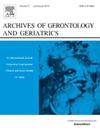Risk factors for sarcopenia in community setting across the life course: A systematic review and a meta-analysis of longitudinal studies
IF 3.5
3区 医学
Q2 GERIATRICS & GERONTOLOGY
引用次数: 0
Abstract
Background
Sarcopenia is generally an age-related condition in older people that impacts adverse health consequences in terms of quality of life, morbidity and mortality. With the increasing interest of clinical and research interest in sarcopenia internationally, the epidemiological evidence reveals sarcopenia risk begins in early adulthood, influenced by gene, lifestyle and a range of chronic conditions across life course.
Objectives
The purpose of this study was to systematically summarize the risk factors for sarcopenia across the life course, and to identity the high-risk population.
Methods
Searches were performed in PubMed, Web of Science, Scopus, Embase, MEDLINE, and SPORTDiscus databases from inception to July 2024. Longitudinal studies assessing the risk factors for sarcopenia in community setting were included in the analysis. Fixed- and random-effect models were used to pool effect size. Based on the results of meta-analysis, we developed a risk predictive model for sarcopenia.
Results
Fifty-three studies were included in our systematic review. Risk factors associating with sarcopenia were grouped into eight domains: sociodemographic, anthropometric, health behaviors, health condition, biomarkers, early life factors, psychosocial and living environment factors. Fifteen risk factors derived from the twenty-three included studies were eligible for meta-analysis, and ten variables were identified as statistically significant. A risk predictive model was developed for secondary sarcopenia in community setting.
Conclusions
This study provides a fully understanding of sarcopenia across the life-course. Our risk predictive model could facilitate the early identification and prevention of secondary sarcopenia in community setting.
Registration
The systematic review and meta-analysis have been registered in PROSPERO(CRD42024536346)
整个生命过程中社区环境中肌肉减少症的危险因素:纵向研究的系统回顾和荟萃分析
骨骼肌减少症通常是老年人的一种与年龄相关的疾病,在生活质量、发病率和死亡率方面影响不良的健康后果。随着国际上对肌少症的临床和研究兴趣的增加,流行病学证据表明,肌少症的风险始于成年早期,受基因、生活方式和生命过程中一系列慢性病的影响。目的本研究的目的是系统总结整个生命过程中肌肉减少症的危险因素,并确定高危人群。方法检索PubMed、Web of Science、Scopus、Embase、MEDLINE和SPORTDiscus数据库,检索时间为建站至2024年7月。评估社区环境中肌肉减少症危险因素的纵向研究被纳入分析。固定效应模型和随机效应模型用于汇总效应大小。基于meta分析的结果,我们建立了肌肉减少症的风险预测模型。结果53项研究纳入我们的系统综述。与肌肉减少症相关的危险因素分为8个领域:社会人口学、人体测量学、健康行为、健康状况、生物标志物、早期生活因素、社会心理和生活环境因素。从23项纳入的研究中得出的15个风险因素符合荟萃分析的条件,其中10个变量被确定为具有统计学意义。建立了社区环境下继发性肌肉减少症的风险预测模型。结论:本研究提供了对整个生命过程中肌肉减少症的全面了解。我们的风险预测模型有助于社区环境下继发性肌肉减少症的早期识别和预防。系统评价和荟萃分析已在PROSPERO注册(CRD42024536346)。
本文章由计算机程序翻译,如有差异,请以英文原文为准。
求助全文
约1分钟内获得全文
求助全文
来源期刊
CiteScore
7.30
自引率
5.00%
发文量
198
审稿时长
16 days
期刊介绍:
Archives of Gerontology and Geriatrics provides a medium for the publication of papers from the fields of experimental gerontology and clinical and social geriatrics. The principal aim of the journal is to facilitate the exchange of information between specialists in these three fields of gerontological research. Experimental papers dealing with the basic mechanisms of aging at molecular, cellular, tissue or organ levels will be published.
Clinical papers will be accepted if they provide sufficiently new information or are of fundamental importance for the knowledge of human aging. Purely descriptive clinical papers will be accepted only if the results permit further interpretation. Papers dealing with anti-aging pharmacological preparations in humans are welcome. Papers on the social aspects of geriatrics will be accepted if they are of general interest regarding the epidemiology of aging and the efficiency and working methods of the social organizations for the health care of the elderly.

 求助内容:
求助内容: 应助结果提醒方式:
应助结果提醒方式:


